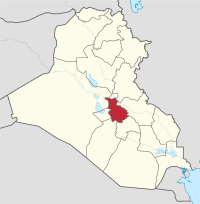Babylon Province
|
Babil Governorate محافظة بابل Babylon Province |
|
|---|---|
| Governorate | |
 |
|
| Coordinates: 32°37′N 44°33′E / 32.617°N 44.550°ECoordinates: 32°37′N 44°33′E / 32.617°N 44.550°E | |
| Country |
|
| Capital | Hillah |
| Area | |
| • Total | 5,119 km2 (1,976 sq mi) |
| Population (2014 Estimate) | |
| • Total | 2,000,000 |
Babil Governorate or Babylon Province (Arabic: محافظة بابل Muḥāfaẓa Bābil) is a governorate in central Iraq. It has an area of 5,119 square kilometres (1,976 sq mi), with an estimated population of 1,651,565 people in 2002. The provincial capital is the city of Hillah, which lies opposite the ancient city of Babylon (بابل), on the Euphrates river.
The ancient city of Babylon in present-day Babylon Province was the capital of ancient Babylonia, situated on the Euphrates river south of Baghdad, Iraq.
The city was occupied from the 3rd millennium BC but became important early in the 2nd millennium under the kings of the First Dynasty of Babylon. The sixth king of this dynasty was Hammurabi (1792–1750 BC) who made Babylon the capital of a vast empire and is best remembered for his code of laws.
The city achieved pre-eminence when Nebuchadnezzar II (605–562 BC) extended the Babylonian Empire over most of Western Asia.
In 1991 Babil Governorate was the center of a Shia uprising.
The province is primarily agricultural, has very fertile soils, and is extensively irrigated with water from the Hilla branch of the Euphrates River, also known as the Hilla River.
Babylon province is located between 32° to 33.25° North latitude and 44° to 45° East longitude. The area is arid to semi-arid and its mean annual rainfall is highly varied ranging from 50 millimetres (2 in) or less to 200 millimetres (8 in). Temperatures in the summer can reach as high as 50 °C, and winters are generally mild.
The Babil Governorate is divided into four districts:
...
Wikipedia
